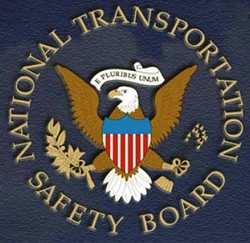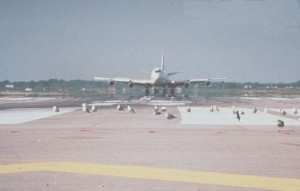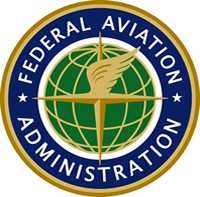Reforms Suggested For Airports, Flight Plans, Maintenance
 The NTSB Tuesday issued a list of
recommendations for changes in FAR's that it says will enhance bird
strike prevention, and beef up safety for charter operators.
The NTSB Tuesday issued a list of
recommendations for changes in FAR's that it says will enhance bird
strike prevention, and beef up safety for charter operators.
For preventing and reporting bird strikes, NTSB said that the
FAA should revise the bird-strike certification requirements for 14
Code of Federal Regulations Part 25 airplanes so that protection
from in-flight impact with birds is consistent across all airframe
structures. Consider the most current military and civilian
bird-strike database information and trends in bird populations in
drafting this revision.
NTSB says the FAA should also verify that all federally
obligated general aviation airports that are located near
woodlands, water, wetlands, or other wildlife attractants are
complying with the requirements to perform wildlife hazard
assessments as specified in Federal Aviation Administration
Advisory Circular 150/5200-33B, Hazardous Wildlife Attractants On
or Near Airports, and require aircraft manufacturers to develop
aircraft-specific guidance information that will assist pilots in
devising precautionary aircraft operational strategies for
minimizing the severity of aircraft damage sustained during a bird
strike, should one occur, when operating in areas of known bird
activity. This guidance information can include, but is not limited
to, airspeed charts that depict minimum safe airspeeds for various
aircraft gross weights, flap configurations, and power settings;
and maximum airspeeds, defined as a function of bird masses, that
are based on the aircraft's demonstrated bird-strike energy.

Finally, NTSB recommends the FAA require all 14 Code of Federal
Regulations (CFR) Part 139 airports and 14 CFR Part 121, Part 135,
and Part 91 Subpart K aircraft operators to report all wildlife
strikes, including, if possible, species identification, to the
Federal Aviation Administration National Wildlife Strike
Database.
For charter operators, NTSB recommends the FAA revise 14 Code of
Federal Regulations 91.23 truth-in-leasing regulations to include
all turbine-powered airplanes. Further, FAA should require that
flight plans include a block for the pilot to identify the operator
and a block to specify the operating rules under which the flight
is being conducted.
 FAA should also require 14 Code of
Federal Regulations Part 135 on-demand operators to provide their
customers with a written document, correspondence, or ticket that
expressly describes the terms of carriage, including the regulatory
part under which the flight is operated, update and keep current
the aircraft charter guide on the Federal Aviation Administration's
website to include reliable information on the certification status
of on-demand commercial operators and the aircraft that they are
authorized to operate, and explore and implement strategies to
improve on-site inspector surveillance activities at airports and
of flight operations to detect and deter improper charter
operations.
FAA should also require 14 Code of
Federal Regulations Part 135 on-demand operators to provide their
customers with a written document, correspondence, or ticket that
expressly describes the terms of carriage, including the regulatory
part under which the flight is operated, update and keep current
the aircraft charter guide on the Federal Aviation Administration's
website to include reliable information on the certification status
of on-demand commercial operators and the aircraft that they are
authorized to operate, and explore and implement strategies to
improve on-site inspector surveillance activities at airports and
of flight operations to detect and deter improper charter
operations.
Finally, NTSB says FAA should assess why its existing policies,
procedures, and practices resulted in a failure to detect the
noncompliant actions of Interstate Helicopters and develop
additional methods, measures, or procedures for performing
inspections of and following up on complaints about 14 Code of
Federal Regulations Part 135 on-demand operators that can
successfully detect noncompliant charter operations.
In addition, NTSB reiterated that all operators of aircraft
equipped with a cockpit voice recorder (CVR) should be required to
(1) test the functionality of the CVR before the first flight of
each day as part of an approved aircraft checklist and (2) perform
a periodic maintenance check of the CVR as part of an approved
maintenance check of the aircraft. The CVR preflight test should be
performed according to procedures provided by the CVR manufacturer
and should include listening to the recorded signals on each
channel to verify that the audio is being recorded properly, is
intelligible, and is free from electrical noise or other
interference. The periodic maintenance check of the CVR should
include an audio test followed by a download and review of each
channel of recorded audio. The downloaded recording should be
checked for overall audio quality, CVR functionality, and
intelligibility.
 Aero-News: Quote of the Day (04.28.25)
Aero-News: Quote of the Day (04.28.25) ANN's Daily Aero-Term (04.28.25): Decision Altitude (DA)
ANN's Daily Aero-Term (04.28.25): Decision Altitude (DA) ANN's Daily Aero-Linx (04.28.25)
ANN's Daily Aero-Linx (04.28.25) Airborne-Flight Training 04.24.25: GA Refocused, Seminole/Epic, WestJet v TFWP
Airborne-Flight Training 04.24.25: GA Refocused, Seminole/Epic, WestJet v TFWP Aero-News: Quote of the Day (04.29.25)
Aero-News: Quote of the Day (04.29.25)





